Discovery Sites
Enlarge
Qumran Caves
Early in 1949 archaeologists identified cave 1, triggering the beginning of an archaeological investigation of the area. Exploration of the cave, which lies one kilometer north of Wadi Qumran, yielded the remains of at least 70 manuscripts, including bits of the original seven Scrolls. The cave’s discovery established the origin of the purchased Scrolls, while archaeological artifacts recovered there confirmed the Scroll dates suggested by paleographic analysis. At the same time the Bedouin continued to search for Scrolls, as these scraps of leather proved to be a lucrative source of income. Fresh material found by Bedouin in other caves proved that the Cave 1 discovery was not an isolated phenomenon in the desert; additional caves with manuscripts also existed.
The years between 1951 and 1956 were marked by accelerated activity in both the search for caves and the archaeological excavation of the Qumran site. An eight-kilometer-long strip of cliffs was thoroughly investigated. Of the 11 Qumran Caves that yielded written remains, five were discovered by Bedouin and six by archaeologists.
Qumran Cave 1 (1Q) – Discovered by a young Bedouin shepherd in 1947 and excavated by archaeologists in 1949. The first Dead Sea Scrolls were found in this cave, later called Cave 1. They were the best-preserved, said to have been protected by tall clay jars with lids intact. This seven-Scroll discovery revolutionized the study of the Hebrew Bible and the origins of Judeo-Christianity. Scrolls found in Cave 1 include the Community Rule, War of the Sons of Light against the Sons of Darkness, Thanksgiving Scroll (Hodayot), Isaiah A and B, Genesis Apocryphon and Pesher Habakkuk (Habakkuk Commentary). When archaeologists excavated the cave, they found additional fragments of these Scrolls and fragments of dozens of other scrolls.

Qumran Cave 2 (2Q) –Discovered by Bedouin in 1952. Cave 2 yielded fragments of many biblical books, including all Five Books of Moses, Jeremiah and Psalms, as well as other works such as Jubilees and the book of Enoch.
Qumran Cave 3 (3Q) – Discovered and excavated by archaeologists in 1952. Cave 3 unearthed a unique two-part copper Scroll, listing what may be sites of the Temple’s buried treasure, hidden throughout the Judean wilderness and Jerusalem area. According to the Scroll, the secret caches held astonishing amounts of gold, silver, copper, and aromatics. Besides the Copper Scroll, Cave 3 also contained fragments of about a dozen biblical and non-biblical Scrolls, including a copy of Jubilees.
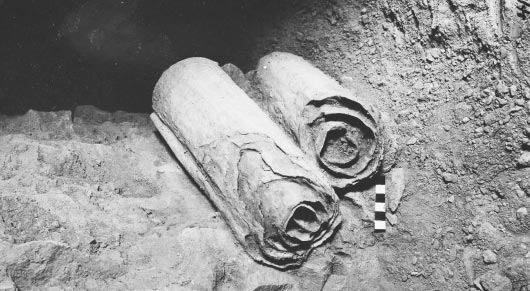
Qumran Cave 4 (4Q) – Discovered by Bedouin treasure hunters in 1952, who were exploring right under the noses of archaeologists excavating the site of Qumran. The most legendary of all caves, Cave 4 revealed ample treasures: thousands of fragments from hundreds of manuscripts, comprising 75% of all material from the Qumran caves, including parts of biblical and apocryphal books, biblical commentaries, works on Jewish law, prayers, sectarian texts, tefillin and mezuzot. Due to their poor condition, these fragments were among the most difficult to decipher and translate.
Qumran Cave 5 (5Q) – Discovered and excavated by archaeologists in 1952. Cave 5 yielded fragments of approximately 25 parchment Scrolls, including biblical and sectarian texts.
Qumran Cave 6 (6Q) –Discovered by Bedouin in 1952. Cave 6 contained fragments of about 31 Scrolls mostly written on papyrus, including biblical works, hymns, and sectarian compositions. This small cave is the most accessible of the Dead Sea Scrolls sites to visitors today.
Caves 7-10 (7Q, 8Q, 9Q, 10Q) –Discovered in 1955 by
archaeologists. All manuscripts found in Cave 7 were in Greek, including
a translation of the book of Exodus. Some scholars have attempted to identify
certain tiny fragments from
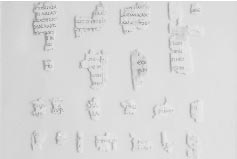 Cave 7 as New Testament texts. Cave 8 contained fragments of Genesis,
Psalms, a mezuzah, a hymn and tefillin. Additionally, the discovery of food
remains, an abundance of oil lamps and 68 leather reinforcing tabs for scrolls
indicate that the cave may have been used as a workshop. Cave 9 yielded
only a single papyrus fragment. Archaeologists found only one inscribed
potsherd in Cave 10.
Cave 7 as New Testament texts. Cave 8 contained fragments of Genesis,
Psalms, a mezuzah, a hymn and tefillin. Additionally, the discovery of food
remains, an abundance of oil lamps and 68 leather reinforcing tabs for scrolls
indicate that the cave may have been used as a workshop. Cave 9 yielded
only a single papyrus fragment. Archaeologists found only one inscribed
potsherd in Cave 10.
Qumran Cave 11 (11Q) – Discovered by Bedouin in 1956. The last of the Qumran Scrolls found to date were discovered in this cave. The remains of around 30 manuscripts were found, including a few nearly-complete Scrolls: Leviticus (written in paleo-Hebrew), Psalms and an Aramaic targum of Job. The most exciting find was the Temple Scroll (the longest of the Dead Sea Scrolls), which rewrites the book of Deuteronomy and details regulations pertaining to Jerusalem and the Jewish Temple.
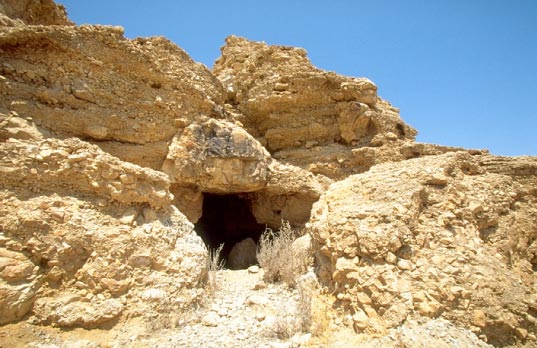
Bar Kokhba Revolt Refuge Caves
In the 1950s and 1960s archaeologists and Bedouin competed for textual finds beyond the Qumran area. The most significant of these manuscripts from other Judean Desert sites are the scrolls dating to the era of the Bar Kokhba Revolt (132-135 ce) recovered from the caves of Wadi Murabba'at and Nahal Hever.
Wadi Murabba'at (Nahal Darga; MUR) – Discovered by Bedouin in 1951. Most of the 170 manuscripts found in the five caves of Murabba'at date to the period of the Bar Kokhba Revolt (132-135 ce). Primarily administrative documents written on papyrus, these financial records belonged to refugees from the revolt who sought shelter in these caves, located about 18 km south of Khirbet Qumran. Textual finds also include letters written by the leader of the revolt himself, Shim'on Bar Kokhba (officially Shim’on, son of Kosiba), as well as a few religious Scrolls, most notably a Scroll of the Twelve Minor Prophets.
nahal hever (hev)
Discovered by Bedouin in the early 1950s. Some Scroll fragments purchased from Bedouin in 1952 were later discovered to have originated in the Nahal Hever caves, located between Ein Gedi and Masada. Full-scale archaeological excavations of the ten Nahal Hever caves (1960-1961) uncovered one of the largest caches of ancient documents found in the Judean Desert. They date to the period of the Bar Kokhba Revolt (132-135 ce). The manuscripts found in these refuge caves include personal documents of refugees, military communications between Bar Kokhba and his officers, and some biblical compositions.
Nahal Hever Cave 5-6 (5/6Hev) – Labeled "Cave of the Letters," this cave contains material with precise dates, ranging from 94-132 ce. It includes three archives:
- A leather waterskin containing 15 letters (in Hebrew, Aramaic and Greek), most of which were sent by Shim'on Bar Kohkba (Shim'on b. Kosiba), the leader of the Bar Kohkba revolt.
- A wrapped package stored inside a leather purse, containing 35 personal financial records, belonging to a woman named Babatha.
- Five contracts belonging to Eleazar, a farmer from Ein Gedi.
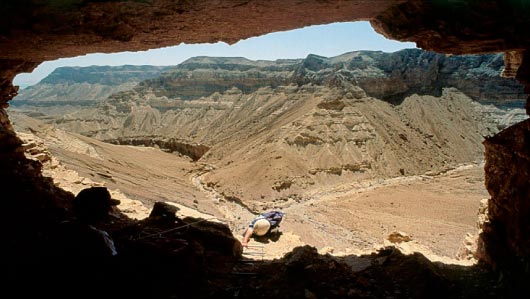
Nahal Hever Cave 8 (8Hev) – This cave is called the "Cave of Horror" because 40 skeletons were found here, the remains of those seeking refuge during the Bar Kokhba Revolt. Archaeologists found three ostraca, which had been placed on the skeletons, inscribed with the names of the deceased. The main textual find was a well-preserved Scroll of the Twelve Minor Prophets in Greek.
Seiyal Collection (XHev/Se) – An assortment of documents sold to the Rockefeller Museum by Bedouin in the 1950s make up the "Seiyal Collection". The origins of these manuscripts are mostly unknown—Bedouin claimed to have found these materials at Nahal Se’elim, but later archaeological excavations proved otherwise for at least some of the fragments. Several "Seiyal Collection" fragments were found to be parts of manuscripts later found at Nahal Hever and a deed of sale originating in Wadi Murabba’at.
Other Discovery Sites
Wadi Daliyeh (Cave of Abu Shinjeh; WD) – Discovered by Bedouin in 1962. A cache of 40 Aramaic papyrus fragments, inscribed seals and coins, and the skeletal remains of 205 people were discovered in this cave, approximately 14 km north of Jericho. These ancient papyri are Samaritan legal documents from the Persian period (4th century bce), mostly deeds of sale for slaves. The owners of the documents were wealthy Samaritans who fled Samaria after the invasion of Alexander the Great in 333 bce, but were likely assassinated by Alexander's troops.
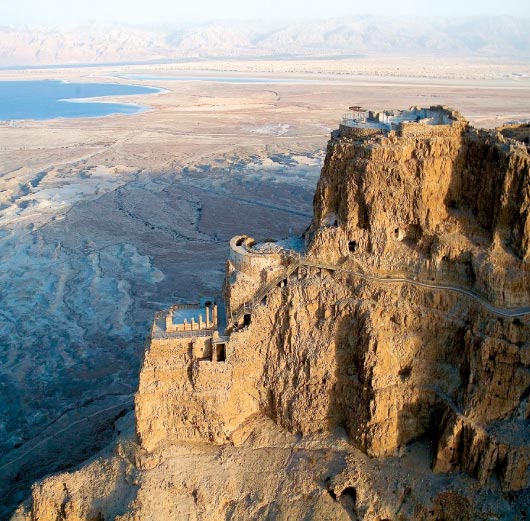
Masada (Mas) – A full scale excavation by archaeologists took place between 1963-65. Masada, a UNESCO World Heritage Site, is best known as the location of the Judean rebels’ dramatic last stand against Rome in the Great Revolt of 66-73 ce. These rebels appropriated Herod's spectacular palace fortress as their opposition base. Manuscripts discovered at Masada were not found in caves, but rather within the structures of the reconfigured palace, near the section identified as a synagogue. Dating to the Roman period, the major discovery here consists of fragments from seven biblical Scrolls (Genesis, two copies of Leviticus, Deuteronomy, Ezekiel, and two copies of Psalms) as well as a copy of the Songs of the Sabbath Sacrifice and a Hebrew text of Ben Sira. The biblical Scrolls match the traditional Masoretic text, which suggests that a stabilized text was already in place by the first-century ce.
Additional findings include Greek and Latin papyri, made up of primarily administrative military documents belonging to Roman soldiers stationed at the site after the revolt. An exception is a scrap of papyrus containing a line from Virgil's Aeneid, "Anna, sister, how my dreams terrify me and leave me hanging!” (IV.9). In this context, the line has been interpreted as reflecting a Roman soldier’s reaction to the sight of the bodies of the martyred rebels.